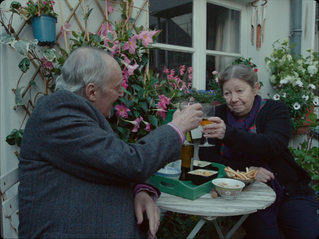Ida
- Isobel Wise
- Mar 6, 2021
- 3 min read
Paweł Pawlikowski, 2013

Boasting a premise that is deceptively simple, Ida is as much a comment upon twentieth-century Polish history as it is an intimate examination of private turmoil. Set in 1960s Poland, the film follows Anna (Agata Trzebuchowska), a young novitiate nun who has been raised in a convent since infancy. After reuniting with her only surviving relative, Anna is told of her Jewish heritage; her birth name is Ida Lebenstein and her family are victims of the former German occupation. Alongside her aunt Wanda (Agata Kulesza), Anna embarks on a pilgrimage to discover the fate of their relatives, uncovering truths that will displace notions of ancestry, purpose and grief on a personal and national scale.
What is so striking about the film is the quiet restraint of its characters. Anna—as statuesque as the figure of Christ she confides in—is devout, pious in terms of both religious reverence and individual sincerity. Clothed in her habit and knitted stockings, only her eyes are exposed; dark orbs that cast out imperturbable and ruminative observations. Introduced in scenes that feature very little peripheral commotion, it is unclear whether the acute serenity of Anna’s world—with its silent suppers and prayers—is an extension of her own placidity or rather her inspiration to adopt such affectations. Indeed, in her interactions with Wanda, there is a degree to which Anna’s stoicism is invented, as opposed to being an intrinsic quality, one that is proved to be somewhat sensitive to her aunt’s teasing and apostasy. However, regardless of the provenance of Anna’s disposition, in contrast to Wanda, it is made practically immaculate. Maintaining the severity from her time as a state prosecutor, Wanda is wounded by her past. If Anna is a novice, her aunt is worldly; her objects of devotion are far more terrestrial in the vices of cigarettes, alcohol and promiscuity. Confident in movement and commanding attention, Wanda rejects the life of ‘chastity, poverty and obedience’ that awaits Anna but shares her niece’s reticence. In truth, the film enjoys minimal dialogue. Conversations are allusive to the substantial topics of anti-Semitism, Stalinism, and atrocities of war, but remain sparse and indirect. Instead, the urgency within each exchange is electric; an invisible but ever-present current conducted through stares and pregnant silences.


As if to follow this specific delineation of emotion preferred by the pair, the film exercises the use of solely diegetic sound. Anna’s boots gnaw at the snow underfoot; a choir of cutlery chimes in the refectory; low rumbles are pronounced by passing trams. These sounds, quotidian in nature, enhance the reserve so expertly maintained by Anna and Wanda, amplifying the immediate intimacy of their efforts to uncover the past. Refusing to bestow external expression upon a narrative characterised by such constraint, music never features as a direct score. Instead, it filters into the film as radio refrains and jazz band performances; it is ambient, sympathetic, unobtrusive.

Equally as ascetic in its aesthetics, the film’s characters move through spaces that are uncluttered and generally unpopulated. They drive along flat, barren farmlands, passing by countryside that has been liberated from war yet still suffers its lingering desolation. Such scenes recount those of Claude Lanzmann’s Shoah (1985), his revisits to Holocaust sites around Poland proving that vegetation and birdsong does little to mask the cavity left behind by such history. The cinematography of Ida is just as austere. Shot in black and white, figures cloister in the lower regions of the screen. The weight of the heavens, or at least vaulted architecture, looms above them, as if anxieties—both individual and national—are rendered as vast and static grey skies and ceilings.

With its visuals, poignant performances and imaginative handling of its aural elements, Ida is a film that burns with a quiet but blistering flame.








Comments